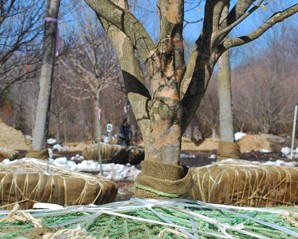When your customers are looking for a large specimen tree, be sure you are prepared to handle it – knowing what’s involved with transporting and planting a larger tree will make the job so much easier. Consider these important 4 points when going big!
1. Truck weight & bed capacity
Know your truck’s weight limit and the length of the bed. Large trees come with heavy root balls – many weighing over 1,500 lbs. and many are 20’+. Most likely some portion will hang over the end so make sure it only extends about 6′ beyond the back of the gate/trailer. Keep a red flag handy to tie onto the end. Good to know – we deliver! We can get the tree to your site if you can’t. (Reminder: Deliveries are only to the driveway or roadside. We cannot drive it to the planting site.)
2. Tarping
This is a must, even when its not fully leafed out. Winds dessicate tender buds early in the season, and will rapidly dry out any plant that is fully leafed out. If you forgot your tarp, you can purchase a lightweight Bempro tarp in the sales office. The bulldog tarps are a heavier duty, perfect for larger material and will last for years.
3. Off-loading at Your Site
It’s important to know the capabilities of your machine on site for off-loading and transporting it to the planting location. Can it handle the weight safely? Is there an unobstructed path to the site or do you have to traverse bluestone walkways or bring it over fences or walls? You may need straps to secure it during transport, and you may need to protect the trunk from machine damage – have some trunk wrap or burlap handy.
4. Planting
– Get it in the ground as soon as possible. If you have to wait make sure you have an adequate water supply. Remember, they receive daily irrigation at the nursery, so make sure you can provide that as well.
– The size of the hole is often skimped on with smaller material – but make sure its not with larger specimens! Dig only as deep as the root ball but twice as wide. Amend soil with organic matter if necessary. Compacted soil from new construction is a good candidate for needing peat moss or composted cow manure. Fill the hole part way with water to check the drainage.
– Before placing it in the hole find the tree’s best face and orient it accordingly. Mark it with ribbon. It’s much easier to turn the tree while on the ground than in the hole.
– Check for the root flare. Many tree plantings fail if planted too deeply. Sometimes extra soil is mounded around the trunk through the balling process so look for the actual root flare by opening up the burlap.
– Once in the hole and you are sure of proper placement, remove the top third of burlap. the bottom two-thirds will naturally decompose over time. The larger material sometimes has a wire basket. Bend the top loops of the basket back and down. It is not, in our view, necessary to remove the wire basket.
– Back-fill with good soil amended with a quality fertilizer like Dry Roots, M- Roots or Roots One Step – ask your salesperson for help with deciding which is best for your specimen. When the hole is half way filled, water well to make sure air pockets are gone. Finish back-filling then water well again.
– Mulch the area with about 3″ of a good natural, un-dyed mulch. Keep mulch away from the trunk by about 6″.
– Set up a watering schedule and monitor the soil during the course of the growing season. Water deeply every 5-7 days. Remember to keep it well hydrated especially going into next winter. On the other hand, over-watering can be detrimental to the tree. Roots need moisture and oxygen!
Stop by soon or give us a call with any questions, we’re here to help!

